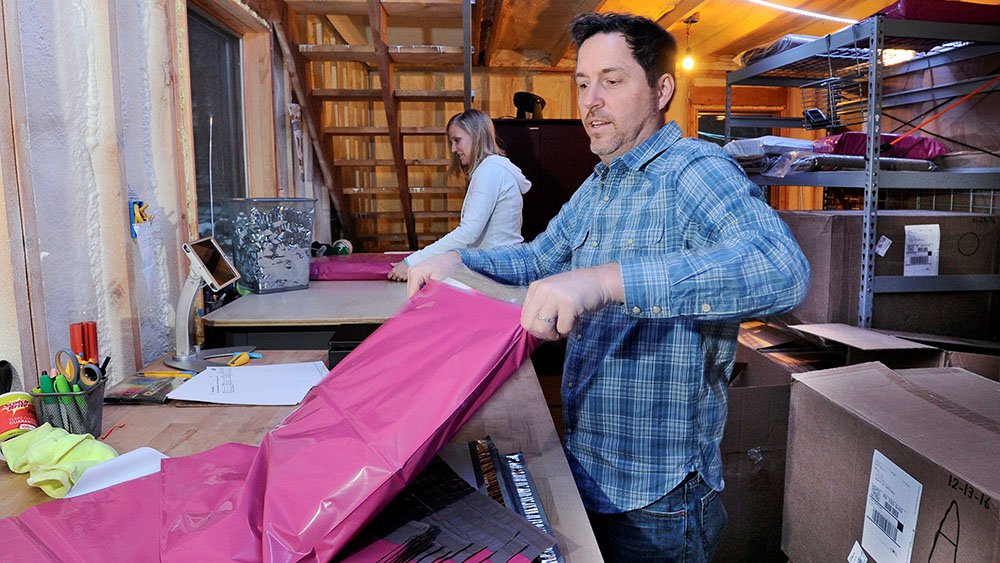
Cats often are maligned for being useless, but Fred Ruckel thinks they’ve proven themselves more handy than humans when it comes to starting a business.
Ruckel is the inventor and founder of something that he calls the Ripple Rug, a compact scratching toy for cats that helps preserve furniture. It’s actually two rugs, one that lay flat on the ground with another on top that features large folds and holes for felines to scratch their way through and satisfy their curious behavior.
The product is catching on with consumers, allowing the company to turn a profit in relatively short order, but Ruckel is far from becoming a corporate titan with thousands of employees under his wing. He and his wife, Natasha, use contract manufacturers to make the Ripple Rug, while they handle the onerous job of shipping from their garage in upstate New York. They plan to eventually combine that function with other ventures under one roof and hire a few employees, but that will take a while.
“To be honest with you, the (economic) environment is extremely hostile right now,” Ruckel said. He later added: “You can turn a profit. You just can’t be greedy.”
Welcome to the world of today’s understated entrepreneur, light years away from the startup founder of yesteryear.
A couple decades ago, a motivated business creator might have sold some major financiers on an idea, hired a slew of employees to help make it happen and, within a couple years, initiated a public offering. Those days are gone. Many of today’s business creators are finding that becoming a big player is a more distant dream than it used to be.
While there are more new businesses being created today, there are fewer with the grand designs of a 1990s tech wunderkind. Business plans are more conservative, the funding is stingier and the jobs simply are not as plentiful.
More Businesses, Fewer Employees
Take a look at the numbers. The U.S. Small Business Administration has stats on business creation dating back to 1994. The last two quarters of 2015 saw the most new firms started over that 22-year period.
From July to December of that year, roughly 498,000 startups were launched, with the fourth quarter edging out the third for the very top spot. But the number of jobs created at those new businesses was anemic. All four quarters of 2015 were in the bottom half of the pack in the number of jobs created, ranking somewhere between 58th and 67th. The average startup created 3.5 to 3.6 jobs that year.
“The number of employees is much lower than in years past,” said Mark Zandi, chief economist for Moody’s Analytics.
Compare that with the height of the 1990s tech boom. The best period for new-business job creation was the first quarter of 1998. At that time, nearly 1.4 million jobs were produced among 222,000 businesses, or roughly 6.2 jobs per new company.
IBD’S TAKE: Even when today’s young tech companies get big, their workforce remains relatively light. Facebook and Alphabet have a far higher revenue-to-employee ratio than General Motors at its peak. Why the tech boom has had a bite-sized impact on jobs and economic growth since the dot-com bust.
Sometimes the contrast can seem startling. Take a look at the worst-ranked period for the actual number of startups — the first quarter of 1994, when 185,000 businesses were birthed, compared with the fourth quarter of 2015 and its 246,000 startups.
That’s a gain of nearly a third in new businesses. Despite a quarter fewer new businesses, the number of jobs created in that 1994 period — 1.14 million — was 27% greater than the 895,000 manufactured during the 2015 quarter.
Hiring Barriers
Holly Wade, director of the National Federation for Independent Business’s research foundation, says job creation is being stifled.
“Hiring a first employee is expensive and it’s becoming more expensive,” she said. “The barrier to hiring is getting greater and greater.”
Regulations that have increased the minimum wage are having a chilling effect, and in many cases it’s easier to contract out work, she says. Many entrepreneurs find it easier to use outside services for any number of tasks: payroll, advertising and even manufacturing. Sometimes business owners send out to have components made, but they aren’t shy about having the main product created elsewhere.
“There are far more manufacturers that are not employers,” she said.
…

